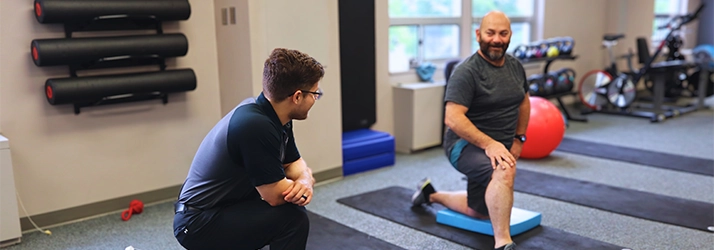Piriformis 101 | Piriformis Trigger Points & Self Piriformis Release

Your piriformis muscle and your psoas muscle work hand in hand to keep your back, hips, and legs properly aligned. When you have tightness in your piriformis muscle or in your psoas muscle, there are several knock-on effects that result in many patients having lower back pain that just won't go away.
In this article, you'll learn what kind of pain is associated with piriformis syndrome. Piriformis syndrome can cause a lot of pain when your piriformis muscle is too tight and we'll show you what stretches you can do to help with piriformis syndrome.
Piriformis Trigger Points & Why They Cause Pain
The piriformis muscle is a small but mighty muscle located deep in the buttock. It starts at the lower spine and connects to the upper surface of each femur or thighbone. The function of the piriformis muscle is to help you rotate your hip and allow you to turn your leg and foot outward. The piriformis muscle right along the sciatic nerve which is why it can create such intense back pain.
The psoas and piriformis muscles are two incredibly important muscles that connect the legs to the spine. When it comes to back pain and dysfunction you can't have trouble in one of these muscles without it affecting the other.
If your psoas and piriformis muscles are both long and toned the spine can comfortably sit directly on top of the pelvis. Problems arise when either the psoas or piriformis is tight. If the psoas muscle is too tight, it will pull the lower part of your spine forward while pulling the upper part of your spine backward. This, of course, has a knock-on effect on the piriformis because it cannot sit in its proper place. If your piriformis is too tight it will pull your feet wider than parallel and turn your inner thighs more toward the front of your body. When your inner thighs do this, the psoas loses the tension that it needs to maintain optimal function without pain.
As you can see, no matter which of these muscles is too tight, it will have a negative impact on the other which will exacerbate your back pain. The psoas and the piriformis have to maintain this critical balancing act to allow you to sit, stand, walk, run, and even sleep properly.
Piriformis syndrome is a neuromuscular disorder that is caused when the piriformis muscle compresses the sciatic nerve. The sciatic nerve passes along or through the piriformis muscle, goes down the back of the leg, and eventually branches off into smaller nerves that end in the feet. Piriformis syndrome usually starts with pain, tingling, or numbness in the buttocks as a result of the sciatic nerve being compressed. The pain tends to be triggered when climbing stairs or sitting for long periods of time perhaps at work or while driving.
A muscle spasm in your piriformis might not sound like such a big deal but the resulting impact of the spasm can lead to piriformis syndrome. A spasm can result in swelling, tightening, or irritation of the piriformis leading to a literal pain in your butt. To add insult to injury, this can also irritate your sciatic nerve causing pain, tingling, or numbness in the back of the thigh, calf, or foot. That leads many people to have pain when they're moving and when they're resting that can be unrelenting and frustrating.
Piriformis Trigger Points
If your piriformis is causing your back pain, you'll likely experience sensitivity to pressure and pain in your buttocks, lower back, and superior lateral side of the thigh. Piriformis trigger points can transmit pain to the back of your thighs so the pain isn't solely concentrated in the buttocks and hip area.
The medial piriformis trigger point lies along the piriformis line about an inch outside the edge of the sacrum which is a large, triangular bone at the base of the spine. The lateral piriformis trigger point is a few inches to the inside of the greater trochanter landmark, along the piriformis line. Both of these piriformis trigger points in the buttocks are capable of transmitting pain to the sacroiliac joint, posterior hip, and general buttock.
Piriformis trigger points cause lower back pain for many people but it is treatable and you can get relief from your pain.
Relieving Piriformis Pain
If you're experiencing lower back pain, it's quite likely that your psoas and piriformis muscles are involved. There are 3 key steps to relieving the pain caused by irritation or injury to these two muscles.
1. Stretch muscles that are tight
You can stretch your muscles on your own with your hands or a foam roller. We're big fans of massage therapy for loosening up those muscles that you're experiencing tightness in.
Be careful if you decide to stretch your muscles at home because it is possible to do additional damage to your sciatic muscle if you don't know what you're doing or if you have problems that go beyond piriformis tightness. If you choose to do a self piriformis release make sure to stretch the unaffected side of your body as well.
2. Exercise muscles that are weak
Everybody has certain muscles in their core that are not as strong as they could be. By doing regular exercises to strengthen your abdominals, glutes, and diaphragm you'll be able to strengthen your core which will create better support for your piriformis and psoas muscles. These regular exercises are key for our patients and they are a simple thing you can do on a daily basis to prevent pain.
3. Have a chiropractic adjustment
You've already taken care of tight and weak muscles so now it's time for a chiropractic adjustment to support your joints. A chiropractic adjustment will improve your spine health and flexibility while relieving some of that back pain you're experiencing.
In addition to easing your pain, our doctors can help you strengthen your piriformis muscle so you can avoid having this kind of pain in the future. We can give you a variety of stretches and exercises you can do at home to strengthen your piriformis muscle and core muscles, ease back pain, and prevent future injury. Click here to schedule your appointment!
OFFICE HOURS
Monday
7:30am - 12:00pm
2:00pm - 6:00pm
Tuesday
7:30am - 12:00pm
2:00pm - 6:00pm
Wednesday
7:30am - 12:00pm
2:00pm - 6:00pm
Thursday
7:30am - 12:00pm
2:00pm - 6:00pm
Friday
7:30am - 12:00pm
Saturday & Sunday
Closed
Kalkstein Chiropractic
200 E Joppa Rd #300
Towson, MD 21286
